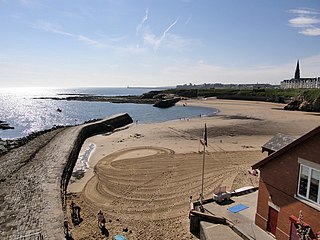
Tynemouth is a large town and a historic county borough in Tyne and Wear, England, at the mouth of the River Tyne, 8 miles (13 km) east-northeast of Newcastle upon Tyne. Historically part of Northumberland, it is administered as part of the borough of North Tyneside, but until 1974 was an independent county borough, which included North Shields. It had a population of 17,056 in 2001. The population of the Tynemouth ward of North Tyneside was 10,472 at the 2011 Census.

Cullercoats is an urban area of North East England, with a population 9,407 in 2004. Historically in Northumberland, it has now been absorbed into the North Tyneside conurbation, sitting between Tynemouth and Whitley Bay. The population of this North Tyneside ward at the 2011 census was 9,202.

Cullercoats is a station on the Tyne and Wear Metro, serving Cullercoats and Marden in North Tyneside. The station joined the network in August 1980, following the opening of the line between Haymarket and Tynemouth – the first stage of the network to open.
Edward "Ned" Corvan was a Tyneside concert hall songwriter and performer, and a contemporary of George "Geordie" Ridley. His songs were printed in a modified English orthography designed to represent the traditional dialect of Tyneside in the middle of the 19th century, and are examples of Dialect Literature.
The Pitman's Courtship is a famous Geordie folk song written in the 19th century by William Mitford, in a style deriving from music hall. This piece takes a humorous look at the courtship of a Pitman and his lass where the discussion forms the proposal of marriage and the couple's plans for a life together. This song was generally considered to be one of the region's finest 'traditional' songs, one of only a handful of Tyneside songs to be appreciated outside the region in its day.
"The Caller" is a Geordie folk song written in the 19th century by Edward “Ned” Corvan, in a style deriving from music hall.
"Wor Peg's Trip te Tynemouth" is a Geordie folk song written in the 19th century by Joe Wilson, in a style deriving from music hall.
Jemmy Joneson's Whurry is a traditional Geordie folk song in Geordie dialect written circa 1815, by Thomas Thompson, in a style deriving from music hall.
"Geordy Black", also known as "Geordie Black" and "I'm Going Down the Hill" is a 19th-century Geordie folk song by Rowland "Rowley" Harrison, in a style deriving from music hall.
James Horsley (1828–1891) was an Alnwick born songwriter, editor, and general handyman. In addition to his songs, he wrote many pieces of poetry about Jesmond. The most well-known of the songs may well have been "'She's sumboddy's bairn".
T. Moor was a Tyneside singer/songwriter of the 19th century. The only song attributed to his name is "The Skipper's Dream".
David Ross Lietch (c1809-1881) was a 19th-century Tyneside born poet and songwriter. His most famous song is the ballad "The Cliffs of Old Tynemouth".
The Shields Garland is a Chapbook of Geordie folk songs consisting of three small volumes, published in the 1850s
John Gair "Jack" Robson was an English schoolmaster, musician and songwriter. Many of his 40-plus songs are in Geordie dialect. His most famous song must be "Whereivvor ye gan ye’re sure te find a Geordie".
T Kennedy was a Tyneside songwriter from the late eighteenth and early nineteenth century. His most famous song is possibly "Geordie's Letter Frae Callerforney ".
Marshall's Collection of Songs, Comic, Satirical is a chapbook style songbook, giving the lyrics of local, now historical songs, with a few bits of other information. It was published by John Marshall in 1827.
James Shotton (1824–1896) was a North Shields born 19th-century artist. He painted a portrait of Thomas Haswell, a North Shields songwriter.
Charles Ernest Catcheside-Warrington (1859–1937) was an English Music hall artist and songwriter from the late 19th century who became a recording artist, record producer and a collector and arranger of "Geordie" songs.
The Cullercoats Fish Lass Is a folk song, written by Edward Corvan, originally printed as a broadside in 1862 and collated in Allan's Illustrated Edition of Tyneside Songs and Readings in 1891.



